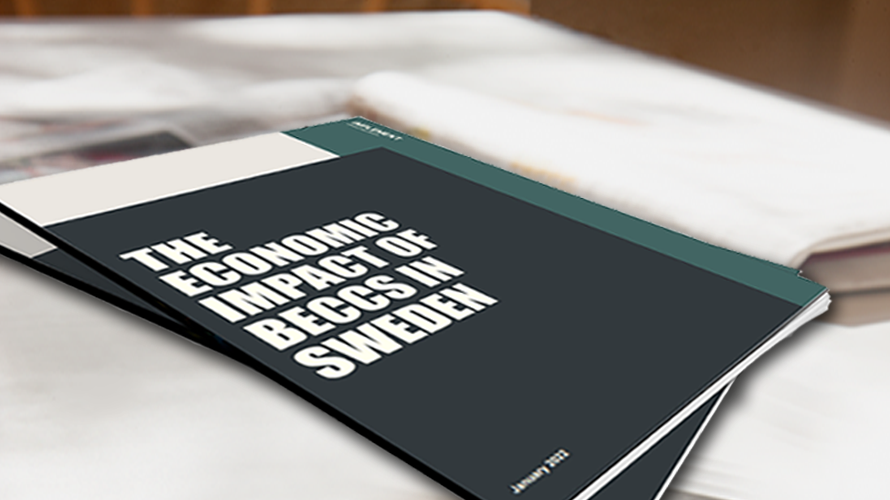BECCS has the potential to be a new industry with positive economic effects for Sweden, according to a new study that Stockholm Exergi commissioned the consulting firm Implement to conduct. If Sweden were to take advantage of the entire country’s potential to capture and store 30 million tons of carbon dioxide per year, it would lead to 11,500 direct employment opportunities and 28,000 jobs in total if counting indirect employment opportunities. It would also contribute SEK 24 billion to Sweden’s GDP.
BECCS, Bio Energy Carbon Capture and Storage, is a technology that creates the so-called negative emissions needed to achieve the Paris Agreement’s goal of counteracting climate change. Sweden has very good conditions to pursue large-scale BECCS due to the country’s well-developed bioeconomy. The potential in Sweden is significantly larger than its domestic need for negative emissions, which opens up opportunities for Swedish actors to fulfill other countries’ and business’ needs for negative emissions. To understand the economic consequences of a BECCS-centered industry, Stockholm Exergi comissioned the Danish consulting firm Implement to conduct an economic impact study.
– The results point to a very clear and positive economic impact. Sweden now has the chance to build a new industry that is necessary for the climate and good for our economy, said Fabian Levihn, head of Research and Development at Stockholm Exergi.
The study shows three primary effects:
- The Swedish Government’s inquiry (SOU 2020: 4) shows that Sweden needs to capture up to 10 million tons of carbon dioxide through BECCS to meet the Swedish net zero target. BECCS increases the economic efficiency of climate change, entailing an annual savings of SEK 10-80 billion per year to reach the target of zero carbon emissions in 2045. If we assume that the latest costs for transport sector emissions reported by the Swedish National Institute of Economic Research to be true, the higher savings of SEK 80 billion per year will be achieved.
- Sweden has very good conditions for BECCS. The potential is much larger than the 10 milion tons of carbon dioxide that are needed to meet Swedish climate goals. With support of Article 6 in the Paris Agreement, Sweden can produce up to 20 million tons per year of negative emissions. Other countries who need to counteract emissions that are difficult to reduce and who could be helped with permanent negative emissions, but lack our beneficial conditions, can therefore take advantage of Swedish negative emissions. According to Implement’s study, profit from such an export and its contribution to the Swedish economy is valued at over SEK 18 billion per year.
- According to Implement’s calculations, constructing and operating an industrial investment with a yearly volume of 30 million tons of permanent negative emissions through BECCS would lead to the creation of 28,000 new employment opportunities in total and contribute SEK 24 billion to Sweden’s GDP. Looking only at the Swedish need for 10 million tons of carbon dioxide per year, 6,700 employment opportunities will still be created and the contribution to Sweden’s GDP would be almost SEK 6 billion.
Even if an investment in BECCS would increase the economic efficiency of climate change and positively impact the Swedish economy, the study also reveals challenges. Not least will the future need for engineering and other specialist skills be critical.
– If Sweden is to succeed in establishing an industry for BECCS, the government needs to continue the path it has taken and ensure that its reverse auction receives enough resources and begins according to plan. We have no time to lose and state support needs to arrive at an early stage in the process. Government support is an investment in the future, said Fabian Levihn.
FACTS: BECCS
BECCS stands for Bio Energy Carbon Capture and Storage and entails capture and storage of carbon dioxide that arises in connection with the incineration of biomass. This creates negative emissions. In this way, the technology contributes to counteracting global warming and, in the long term, return the climate to sustainable levels. BECCS is necessary to meet the far-reaching ambition of negative emissions that, according to the UN’s climate panel IPCC, are needed to reach climate goals.
Stockholm Exergi, with support from the Swedish Energy Agency, has installed a testing facility at the biomass-powered combined heat and power (CHP) plan in Värtan. It was inaugurated in December 2019. Stockholm Exergi’s goal is to establish a large-scale facility for BECCS that will be completed in the end of 2025. Stockholm Exergi’s calculations show that there is potential to capture 800,000 tons of carbon dioxide per year at the CHP plan in Värtan. Stockholm Exergi’s large-scale BECCS project has received 180 million EUR in EU funding.

